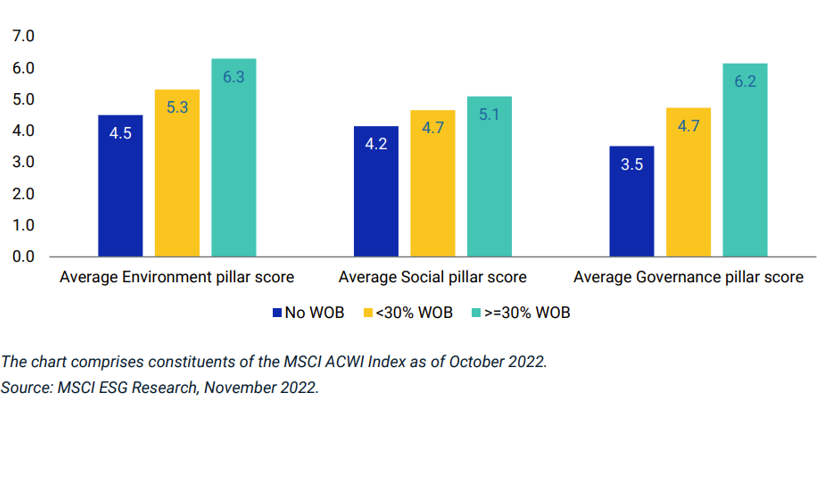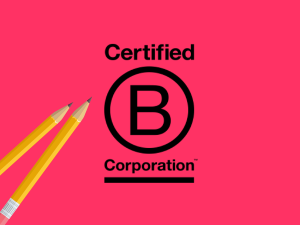The great gender rebalance

Today, three years ahead of the December 2025 target, Financial Times Stock Exchange (FTSE) 350 companies now meet the 40% target for women on boards 1 . Women Chief Executive Officers (CEOs) in the US currently run more than 10% of Fortune 500 companies 2 for the first time in history. And in the UK, Cheryl Potter was recently appointed to the Board of Marks & Spencer, a major multinational retailer, creating a female majority board for the first time in the company’s history 3 .
According to Morgan Stanley Capital International (MSCI), the percentage of director seats held by women increased in 2022, reaching 24.5% among constituents of the MSCI All Country World Index (ACWI) Index, up from 22.6% the previous year 4 . The percentage of Index constituents with at least 30% female directors also increased in 2022 to 38% compared with 33% a year ago 5 .
It feels like some progress is being made with gender balance in the workplace.
Regulations driving gender balance
Without entering the debate around whether regulations and quotas are the right or wrong way to achieve gender balance, different tools do different jobs. If we’re to reimagine and rebuild our businesses, we need all the tools at our disposal.
France is one of the most progressive EU Member States for women on boards. A 2011 law phased in a 40% quota to improve gender balance on management boards 6 in companies listed on the stock exchange (“CAC 40”), or those with more than 500 employees and turnover exceeding €50 million over the previous three years. The law faced some criticism as the parity it sought to create was capped at board level without extending to any other management, strategic or commercial roles.
This changed last year when the Rixain Law 7 was passed, increasing gender quotas applicable to management bodies and senior executives of large companies. From the 1st of March, 2026, large French corporates (> 1,000 employees over the past three years) will be required to ensure that the proportion between the two genders within their senior executives and members of their management bodies cannot be less than 30%. This quota will increase to 40% from the 1st of March, 2029.
In the EU, new rules adopted in 2022 ensure that at least 40% of non-executive director positions in listed companies are held by members of the underrepresented sex by 2026 (female or male). If Member States choose to apply the new rules to both executive and non-executive directors, the target would be 33% of all director positions by 2026 8 . Out of the 328 constituents of the MSCI ACWI Index domiciled in the EU, nearly half (47.3%) have already reached this 40% threshold 9 .
In the UK there are no regulations or laws defining set quotas at board or senior management level for female leaders. The approach is voluntary and championed by the likes of the 30% Club 10 , Level 20 11 , Women on boards 12 , FTSE Women Leaders Review 13 amongst others. The UK has a board and senior management diversity regulation – The Equality Act 2010. This legally protects people from discrimination in the workplace and in society more widely. Despite quotas being entirely voluntary, the UK is now second in international rankings for women’s representation on boards at FTSE 100 level, with nearly 40% of positions now held by women, compared with 12.5% ten years ago 14 – promising progress.
Female founded businesses
According to the 2023 Rose Review Progress Report 15 , 2022 saw the total number of all-female firm incorporations in the UK increase by 4%. Since the launch of the Rose Review in 2019, there have been more than twice as many female-led business incorporations reported 16 .
One-third of high-growth businesses worldwide are now run by women 17 according to the Global Entrepreneurship Monitor. Women entrepreneurs in upper–middle-income countries represent some of the most innovative, high-growth entrepreneurs globally, and are at parity with men regarding international market focus 18 .
Interestingly, the highest start-up rate for women was found in the Dominican Republic, where nearly 44% of women reported start-up activity compared to 40% of men. In contrast, the lowest startup rates for women were found in Poland (1.6%) and Norway (1.7%), which also showed the largest gender gap with only two women entrepreneurs for every five men 19 . Norway presents a conundrum given it regularly ranks in the top five for female leadership at the board level and is driving even further with new proposals for diversity quotas with unlisted firms 20 .
Female led performance
Whilst there are many studies looking at the link between female representation and financial performance, no direct causal link has been found. However, correlations do exist between female leadership and improved financial performance 21 in multiple business areas. MSCI reports on performance across the three Environment, Social and Governance (ESG) pillars which shows a notable link between female leadership and improved performance.

The rise of female founded mission driven businesses is also growing (currently 23% of B Corps in the UK are women-owned 22 and this is set to rise with a renewed and greater focus on female founders).
Women in the workplace are rising. And as they rise, our ability to tackle some of the world’s largest global challenges increases. That is something to celebrate this International Women’s Day.
Footnotes
- Scroll to footnote
- Scroll to footnote
- Scroll to footnote
- Scroll to footnote
- Scroll to footnote
- Scroll to footnote
- Scroll to footnote
- Scroll to footnote
- Scroll to footnote
- Scroll to footnote
- Scroll to footnote
- Scroll to footnote
- Scroll to footnote
- Scroll to footnote
- Scroll to footnote
- Scroll to footnote
- Scroll to footnote
- Scroll to footnote
- Scroll to footnote
- Scroll to footnote
- Scroll to footnote
-
Who is missing from the B Corp community?, B CorporationScroll to footnote




